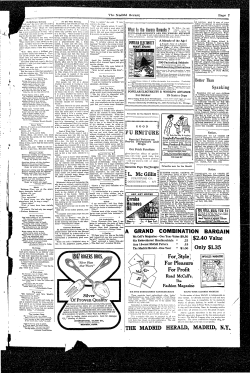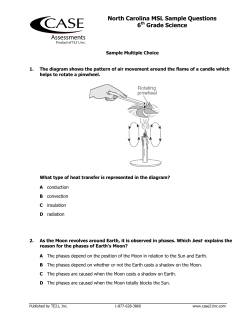
Wednesday, October 22, 2014 POSTER SESSION: POSTER SESSION
Annual Meeting of the Lunar Exploration Analysis Group (2014) sess201.pdf Wednesday, October 22, 2014 POSTER SESSION: POSTER SESSION 5:30 p.m. Bldg. 200, Lobby Kring D. A. Production of Volatiles at Lunar Pyroclastic Volcanic Vents [#3056] Significant masses of CO, CO2, and H2O can be released by pyroclastic eruptions. Fink H. Lunar Surface Models [#3010] Lunar surface models in raised relief give the user a tactile impression of the terrain shown on the map. Robinson M. S. Lawrence S. J. Speyerer E. J. Stopar J. D. Intrepid: Lunar Roving Prospector — Providing Ground Truth and Enabling Future Exporation [#3026] We propose a long range lunar roving prospector, Intrepid, to collect essential measurements to address key questions and demonstrate technologies required for future robotic and human exploration of the Moon, Mars, and other terrestrial bodies. Guven U. G. Velidi G. V. Datta L. D. Space Mission to the Moon with a Low Cost Moon Probe Nanosatellite: University Project Feasibility Analysis and Design Concepts [#3005] This paper discusses the possibility of launching a 10 kg nanosatellite moon probe with a joint university effort along with industrial partners for a low cost mission to the moon. It will allow for vital experiments to take place. Guven U. G. Why Do We Need the Moon: Next Steps Forward for Moon Exploration [#3036] This paper outlines the various possibilities for the future of the moon and it details how it can be beneficial for future space technology endeavors and discusses alternatives of Nanosatellite Moon missions as well as private sector missions. Knicely J. Rickman D. Inversion Algorithms to Determine Likely 3D Solids from a Population of Particles [#3027] The 3D shape of particles affects many aspects of science and engineering. Two inversion algorithms were developed to determine sets of 3D solids that approximate the 2D measures of a population of particles of lunar regolith and lunar simulant. Leiter R. M. Himwich Z. Natarajan A. Rosenthall J. Clark P. E. Small Payloads and Advanced Concepts for Exploration (SPACE) Early Mission Design Tool [#3009] This tool allows scientists and engineers in early phases of mission development to select a compact instrument for a science application and find initial estimates mass, power, volume, and bandwidth for a specific nanosatellite mission. Lawrence S. J. Robinson M. S. Stopar J. D. Speyerer E. J. Jolliff B. L. Lunar Surface Traverse and Exploration Planning: Farside Locations [#3069] We describe morphometric properties of farside exploration destinations. Huber S. A. Hendrickson D. B. Jones H. L. Thornton J. P. Whittaker W. L. Wong U. Y. Astrobotic Technology: Planetary Pits and Caves for Science and Exploration [#3065] This paper describes lunar pits and caves as a potential destination for future science and exploration missions and crewed lunar outposts. Clark P. E. Didion J. Cox R. An ALSEP-Like Lunar Surface Science Package in a Cubesat Form Factor? [#3008] How scalable is the thermal design developed for the ALSEP-like LEMS (without RTGs or RHUs) concept for Project Constellation to a cubesat form factor package? Annual Meeting of the Lunar Exploration Analysis Group (2014) sess201.pdf Wilson J. K. Schwadron N. Spence H. E. Case A. W. Golightly M. J. Jordan A. P. Kasper J. Looper M. D. Mazur J. E. Petro N. E. Robinson M. S. Stubbs T. J. Zeitlin C. Blake J. B. Smith S. S. Townsend L. W. Lunar Proton Albedo Anomalies: Soil, Surveyors, and Statistics [#3006] We see several regional features in the map of lunar albedo protons. We consider several natural sources for the features, as well as man-made anomalies and statistical artifacts. Stickle A. M. Patterson G. W. Bussey D. B. J. Cahill J. T. S. Mini-RF Team Mini-RF Observations of Mare Ejecta Emplacement Diversity [#3064] Significant diversity is seen in the radar scattering characteristics of mare crater ejecta. Here, signatures of subsurface layering emplaced on the lunar surface following impact events are observed using Mini-RF radar data. Barker M. K. Mazarico E. Neumann G. A. Smith D. E. Zuber M. T. Coregistration of Elevation Data from the Lunar Orbiter Laser Altimeter and the SELENE Terrain Camera [#3034] Our goal is to produce the most complete, accurate, and precise global terrain model of the lunar surface by coregistering and merging the digital elevation models from LOLA and the SELENE terrain camera. Chi P. J. Investigation of Ionized Volatiles and Interior Structure of the Moon: Implications from Restored Apollo Magnetic Field Data [#3020] The restored Apollo magnetic field data have revealed ion cyclotron waves that suggest the presence of ionized volatiles from the Moon. Further restoration of the Apollo-era data can help probe the electrical conductivity of the lunar interior. Mazarico E. Nicholas J. B. McClanahan T. P. Neumann G. A. Lunar Polar Illumination Modeling to Support Data Analysis [#3022] We show that illumination modeling at the lunar poles can be useful to support calibration and analysis of lunar datasets such as the neutron data, in particular when studying timevariable effects and correlation with time of day. Murray J. Su J. J. Sagdeev R. Chin G. McClanahan T. P. Livengood T. Starr R. D. Evans L. G. Cross Calibration of Omnidirectional Orbital Neutron Detectors LPNS of Lunar Prospector and SETN/LEND of Lunar Reconnaissance Orbiter [#3045] In this research we cross calibrate the omnidirectional neutron detectors from Lunar Prospector mission and Lunar Reconnaissance Orbiter mission by Monte Carlo simulations. Swain R. K. Lunar Gene Bank for Endangered Species [#3004] The concept of a gene bank in the lunar polar craters provides a permanent solution to the menace of endangered species and the failure of the prevailing strategies to protect them. This is one vital, technologically viable yet cost effective option. Mahanti P. Robinson M. S. Lawrence S. J. Stelling R. Boyd A. Communication and Illumination Conditions at Ina-D — An Information Fusion Approach for Lunar Exploration Planning [#3055] Knowledge of line-of-sight and solar illumination conditions (LoSSIC) drive lunar surface exploration planning. LoSSIC information derived from LROC NAC DTMs is used to greatly enhance communication and traverse planning on the lunar surface. Annual Meeting of the Lunar Exploration Analysis Group (2014) Petro N. E. Keller J. W. Five Years at the Moon with the Lunar Reconnaissance Orbiter (LRO): New Views of the Lunar Surface and Environment [#3059] The Lunar Reconnaissance Orbiter (LRO) has been orbiting the Moon for over five years. During that time, data from the seven instruments onboard the spacecraft have made significant advances in our understanding of the Moon and its environment. Lucey P. G. Abshire J. B. Sun X. Neumann G. A. Mazarico E. M. A Laser Spectrometer for Global Mapping of the Abundance, Distribution and Variability of Water on the Moon [#3035] A multispectral laser spectrometer under development at Goddard Space Flight Center can definitively detect and map surface ice from orbit, and also quantify the abundance and variation of global bound water at the 10–100 ppm level. sess201.pdf
© Copyright 2025












